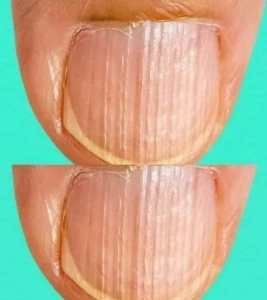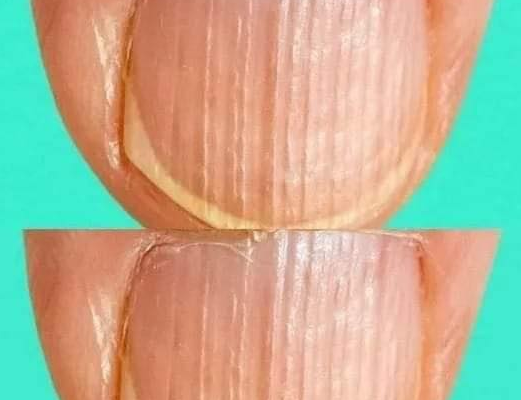Rippled Fingernails Reveal Secrets of Possible Disease
Your fingernails may seem like a small and ordinary part of your body, but they are actually a mirror of your overall health. The color, shape, and texture of your nails can provide valuable clues about what’s happening inside your body — sometimes even before symptoms appear elsewhere. Among the many changes that can occur, rippled or pitted nails are among the most telling.
These tiny ridges or indentations might seem harmless or cosmetic, but in some cases, they can signal underlying health conditions that deserve attention. Let’s explore what rippled fingernails can reveal about your body, the science behind it, and when to seek medical advice.
Understanding the Nail’s Structure
To understand what causes ripples or dents in the nails, it helps to know how healthy nails form.
Each nail grows from a region under the skin called the nail matrix, located just beneath the cuticle. The matrix is where new nail cells are produced. As these cells multiply, they push older ones forward, forming the visible nail plate. If the matrix becomes damaged or disrupted, the nail may grow unevenly, resulting in ridges, waves, or small pits.
In other words, your nail’s surface can act like a “growth record,” showing evidence of stress, nutritional deficiencies, or disease processes that affect the nail matrix.
Types of Nail Ripples and What They Mean
Not all ridges are the same. Doctors often categorize nail irregularities into two main types:
-
Vertical ridges (running from the cuticle to the tip)
-
Horizontal ridges (running side to side across the nail)
Both types can tell different stories about your body’s internal health.
1. Vertical Ripples (Longitudinal Ridges)
Vertical ridges are the most common and often appear naturally with age. As we grow older, the rate of cell turnover in the nail matrix slows down, causing subtle texture changes. However, when these ridges become more pronounced or appear suddenly, they may indicate:
-
Nutrient deficiencies, such as lack of iron, zinc, or vitamin B12
-
Dehydration or chronic dryness
-
Poor circulation affecting nail growth
-
Autoimmune disorders, such as rheumatoid arthritis
Vertical ridges that deepen over time can sometimes signal a more chronic imbalance in the body, particularly when accompanied by brittle or discolored nails.
2. Horizontal Ripples (Beau’s Lines)
Horizontal ridges or indentations are often more concerning. Known medically as Beau’s lines, they form when growth in the nail matrix is temporarily interrupted. This disruption can occur due to:
-
Severe infection or high fever (like pneumonia or influenza)
-
Major stress or trauma to the body
-
Chemotherapy or radiation treatment
-
Uncontrolled diabetes
-
Zinc deficiency
-
Circulatory disorders or poor oxygen flow
In some cases, each ridge corresponds to a specific time when the body was under stress. Doctors can even estimate when the event occurred based on how far the ridge is from the cuticle, since nails typically grow about 3 millimeters per month.
Pitted or Dented Nails
Sometimes, instead of smooth ridges, the nails develop small dents or pits — tiny depressions that make the surface look uneven or textured like sandpaper. This is known as nail pitting, and it often points to inflammatory conditions such as:
-
Psoriasis: One of the most common causes of nail pitting. Up to 50% of people with psoriasis (a chronic skin condition) experience changes in their nails, including pits, thickening, or discoloration.
-
Alopecia areata: An autoimmune disease that causes hair loss and can also affect the nails.
-
Eczema or dermatitis: Chronic inflammation can interfere with nail growth.
-
Reactive arthritis: An immune system reaction sometimes triggered by infection, which may cause nail changes along with joint pain.
These pits occur because inflammation damages the nail matrix during growth, creating uneven texture as new cells form.
When Ripples Come with Other Symptoms
Rippled nails can sometimes appear alongside other visible nail changes, each hinting at specific health issues:
-
Yellow or thickened nails may signal fungal infection or respiratory problems.
-
Blue or purplish nails can indicate oxygen deficiency or heart issues.
-
Spoon-shaped nails (concave surfaces) are associated with iron-deficiency anemia.
-
Dark lines or streaks under the nail should always be checked, as they can rarely be linked to melanoma (a form of skin cancer).
If rippling or pitting appears suddenly, spreads quickly, or occurs with changes in nail color or shape, it’s a good idea to consult a healthcare provider.
The Role of Nutrition
One of the most common reasons for ridged or unhealthy nails is nutritional imbalance. Nails require steady supplies of vitamins, minerals, and proteins to grow properly. Deficiencies in these nutrients can make the nail matrix weaker or irregular:
-
Biotin (Vitamin B7): Supports keratin production, essential for smooth nail growth.
-
Iron: Prevents anemia, which can reduce oxygen flow to the nail bed.
-
Zinc: Helps with cell division and tissue repair.
-
Omega-3 fatty acids: Keep the nail bed hydrated and flexible.
-
Vitamin A and C: Support collagen formation and prevent brittleness.
A well-balanced diet rich in leafy greens, lean proteins, nuts, seeds, and whole grains can make a noticeable difference in nail texture and resilience.
Systemic Diseases Connected to Rippled Nails
Beyond nutrition, rippled or pitted nails can reflect deeper systemic issues. Here are some conditions commonly linked to abnormal nail texture:
-
Psoriatic arthritis: Combines symptoms of joint inflammation and nail deformities.
-
Thyroid disorders: Both hyperthyroidism and hypothyroidism can cause brittle, ridged nails.
-
Lupus and other autoimmune diseases: Chronic inflammation affects nail growth cycles.
-
Diabetes: Poor circulation and changes in blood sugar can impact the nail matrix.
-
Kidney or liver disease: These conditions can alter the chemical composition of keratin, leading to texture changes.
Doctors sometimes use nail condition as a clue during diagnosis, especially when combined with other physical symptoms like fatigue, rashes, or hair loss.
Prevention and Care
While not all nail ridges can be prevented — especially those related to aging or genetics — you can still protect nail health with consistent care:
-
Moisturize regularly. Apply hand cream or cuticle oil daily to prevent dryness.
-
Avoid harsh chemicals. Limit exposure to nail polish removers containing acetone or cleaning products that strip natural oils.
-
Keep nails trimmed and clean. Gentle filing prevents splitting and further damage.
-
Stay hydrated. Drinking enough water keeps nails flexible.
-
Wear gloves when cleaning. This reduces chemical and water damage to nails.
-
Eat a nutrient-rich diet. Focus on foods high in protein, vitamins, and minerals.
If you have a chronic condition such as psoriasis, diabetes, or thyroid imbalance, managing that disease effectively can help your nails return to a healthier state over time.
When to See a Doctor
You should consult a healthcare professional if:
-
Rippling or pitting appears suddenly or severely.
-
The nails change color, thicken, or lift away from the nail bed.
-
You experience pain, swelling, or inflammation around the nails.
-
Other symptoms (like fatigue, rash, or hair loss) occur alongside nail changes.
A dermatologist or primary care physician may perform a simple nail exam, check your medical history, and order blood tests to uncover possible nutritional or autoimmune causes.
Final Thoughts
Your nails are more than decorative — they’re diagnostic. Rippled, pitted, or ridged fingernails can act as subtle signals that something deeper is happening inside the body. While some causes are harmless, others may point to conditions like psoriasis, thyroid imbalance, or nutrient deficiency.


